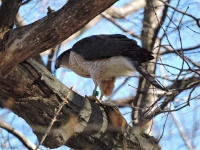But now, they realized they were not the only ones on a hunt. The Cooper’s Hawk had snatched the chipmunk up and held him in the grip of her strong talons.
The students watched intently as she munched on her early spring lunch, fascinated by witnessing the food chain playing out in from of them. The educator leading this group snapped a few photos to capture the moment.
Later, when looking back at the photos the educator noticed a small metal band around one of the hawk’s feet. That’s when our Research and Community Science team started to investigate. They enlisted the help of Bill Stout, a hawk researcher in the area. They remembered that in 2010, a whole gaggle of mesmerized kids watched in awe as Bill brought down a nestlings Cooper’s Hawks from the nest so they could see as he put a band on their ankles. Could this be one of those nestlings?
After looking up the band number, Bill reported back that the hawk is a female and was banded in Riverside Park in 2010 when she was just one year old. It was one of those nestlings! And with this sighting, they were able to update the data on the now mature female hawk and add another chapter to her story.
An amazing thing happened that day. A group of young students were ecstatic to witness something fairly rare, and in doing so, they learned a very important lesson about our natural world. That’s the essence of the Urban Ecology Center – moments of amazing experiential education in action, dedicated ecological analysis, astute awareness of important detail, inspired learning and curiosity. We might have inspired a few scientists that day!
Just as in the food chain, everything in nature is related and depends upon something else to survive. These special moments are made possible by your generosity and commitment to environmental education. Thank you for inspiring future scientists!
Cowritten by Cassie Mordini, Donor Relations Manager and Ken Leinbach, Executive Director





